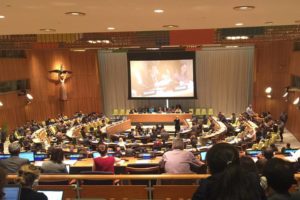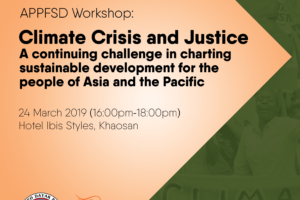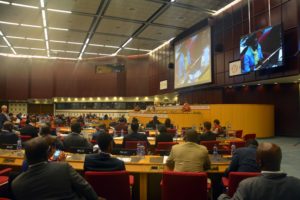IBON International Feature Series #1
The United States Agency for International Development (USAID) exerts a surprising amount of influence over Philippine policymaking process through technical assistance. One aim of this technical assistance has been to refocus government attention and resources on bolstering key areas of the Philippine economy. This refocusing has been done in part through the use of public-private partnerships (PPPs) for targeted infrastructure construction.
Its influence is perhaps expected, given the fact that the combined five-year operating budgets for two of its projects—COMPETE (US$22.5 million) and TRADE (US$12.8)—is already greater than the 2016 budget for the National Economic and Development Authority (NEDA), which amounts to ₱1.286 billion or US$27.7 million. These and other USAID projects are part of the Partnership for Growth (PFG), a White House initiative, through which the US and Philippine government officials jointly set development priorities for NEDA’s Midterm Philippine Development Plan. All of this implies a level of policymaking influence far beyond whatever might be conjured up by the neutral-sounding label “technical assistance.”
The USAID COMPETE team occupies institutional space as a member of the secretariat of the Technical Working Group (TWG) of the Convergence Program between the Department of Tourism (DOT) and the Department of Public Works and Highways (DPWH). From this position, it has wielded significant power to shape agendas. Among its accomplishments in 2013, for example, COMPETE highlighted the technical assistance provided to DOT and DPWH for the identification of tourism road projects. Budget revisions followed, resulting in a 37% increase in the allotment for tourism roads (from US$279 million in 2013 to US$381 million in 2014).[1]
While infrastructure needs are certainly dire, it is questionable whether tourism roads should be such a national budget and development priority if the goals include equity and sustainability. There are also implications for governance. Given that USAID’s policy framework remains explicitly tied to the US national security agenda,[2] and guided by powerful US corporate interests,[3] it is alarming that it was allowed to exert such influence in identifying and setting priorities for viable infrastructure projects and key industries. Also, the fact that PPPs figure so strongly in its prescriptions is cause for alarm since there is little clear evidence for the efficacy of PPPs in achieving positive development outcomes, and much evidence to the contrary.[4]
Both academic and institutional researchers have pointed out that the cost of PPP infrastructure projects often exceeds the costs of comparable public projects. The reasons include higher private sector borrowing costs relative those of the public sector, and incentives for governments not to reveal PPP-contingent liabilities. There have also been many reports of deteriorating service, particularly where PPPs involve social services. The famous case of the Lesotho hospital PPP has been an important reminder of both.[5
The World Bank, IMF and European Investment Bank (EIB) have all released studies identifying cases where governments have borne increased burdens as a result of PPP projects. This is in contrast to proponents who claim that PPPs reduce risk. Yet, USAID has continued to maintain a startling degree of confidence in its frequent PPP prescriptions.
USAID’s unwavering confidence, in fact, seems to have helped pave the way for former president Benigno Simeon Aquino’s passage of the PPP Act, which constitutes a comprehensive privatization program. This controversial Act brings together key policy prescriptions in a manner unprecedented in the Philippines and possibly the world. For instance, the Act provides generous regulatory risk guarantees (of the kind in force in the Lesotho hospital PPP), even creating a permanent public fund for this purpose in the national budget. It grants tax exemptions for PPP projects such as those connected to the construction and/or operation of power plants, toll roads and mass transportation. Moreover, the Act establishes an alternative dispute resolution (ADR) system, giving investors a venue outside the courts to resolve cases filed by consumers and other stakeholders. This measure has the effect of narrowing the mandates of regulatory bodies and institutionalizes procedures of “justice” biased in favor of investor interests, resulting in diminished social accountability.
A 2006 USAID-funded technical report foreshadowed elements of the recent PPP Act. Entitled, “A Proposed BOT [Build-Operate-Transfer] Bill to Enhance Public-Private Partnership in Infrastructure Development,” the report emphasizes the necessary role of government subsidies in enhancing the viability of PPP projects from the perspective of potential private sector partners. It also asserts the necessity of operational components that “facilitate smooth implementation with hardly any contractual dispute requiring court intervention emerging.”[6] This report became the basis for the bills to amend the BOT Law submitted to the 14th and 15th Congress. By the time the PPP Act was passed, the government subsidy proposition had returned in the form of the Contingent Liability Fund (section 24) and Viability Gap Funding (VGF) (section 3). The VGF provision commits the government to the subsidization of the difference between contract-stipulated and actual profits in the event that the latter prove to be less than the former.[7]
In terms of actual PPP projects, USAID activities have recently centered on two in particular: the Bohol Water and Sanitation (BWS) project and the Laguna-Lakeshore Expressway-Dike (LLED) project. Of these two, the LLED is by far the larger. In fact, had it moved beyond the bidding phase, it would have been the largest PPP project undertaken during the Aquino administration (with a budget of US$2.73 billion).A measure of its influence, the USAID COMPETE year-two report states that “the LLED Project was not on the original list of the government’s PPP projects [. . .]. But now, it is No. 1 on the list and the biggest PPP project to date.”[8]
The project reportedly entails the eviction of tens of thousands of families[9] and this displacement has already been underway.[10] The rush to complete the project, moreover, resulted in systematically ignoring serious ecological and safety hazards despite concerted attempts by scientists and community organizations to bring this to the government’s attention.[11][12]
The LLED stands as a striking example of the manner in which so-called “development projects” such as those promoted by USAID and its PPP agenda are driven by priorities and private interests that have little to do with equity and sustainability. Real development would benefit the low-income families in the Laguna area, rather than destroying their homes.
The potentially catastrophic social costs of the LLED project are discussed in our article, “USAID-led Laguna Lake project: Social-Ecological disaster in the making.”
*Portions of this article have been originally published in the Reality of Aid 2016 Report on Technical Cooperation as an Aid Modality.
[1] USAID (2013), Advancing Philippine Competitiveness (COMPETE) Project: Year 1 Annual Report, (Washington, DC: USAID), https://dec.usaid.gov/dec/GetDoc.axd?ctID=ODVhZjk4NWQtM2YyMi00YjRmLTkxNjktZTcxMjM2NDBmY2Uy&pID=NTYw&attchmnt=VHJ1ZQ==&rID=MzU0OTE3, accessed 16 Jun. 2016.
[2] For a summary of the basis of the USAID policy orientation, see USAID’s Policy Framework 2011‒2015, Securing the Future, and Building Trade Capacity in the Developing World, all of which are available at: http://usaidprojectstarter.org/content/cdcs-country-development-cooperation-strategy, accessed 24 Jun. 2016.
[3] See Appendix A: Table 1.
[4]Jomo KS, AnisChowdhury, Krishnan Sharma and Daniel Platz (2016), “Public-Private Partnerships and the 2030 Agenda for Sustainable Development: Fit for Purpose?” DESA Working Paper (New York: UN), https://sustainabledevelopment.un.org/content/documents/2288desaworkingpaper148.pdf, accessed 5 Jun. 2016.
[5] Ibid. For more about the Lesotho hospital PPP, see Oxfam (2014), “A Dangerous Diversion: Will IFC’s Flagship health PPP bankrupt Lesotho’s Ministry of Health?” Oxfam Briefing Note (Oxford: Oxfam), https://www.oxfam.org/sites/www.oxfam.org/files/file_attachments/bn-dangerous-diversion-lesotho-health-ppp-070414-en_0.pdf, accessed 5 Jul. 2016
[6] Dante B. Canlas et al. (2006), “A Proposed BOT Bill to Enhance Public-Private Partnership in Infrastructure Development” (Makati City, Philippines: EMERGE), p. 23, http://pdf.usaid.gov/pdf_docs/PNADH616.pdf, accessed 5 Jul. 2016.
[7] For a more detailed analysis of this and the contingent liabilities fund, see the section “Less regulation, more burden” in IBON (2015), “PPP Act: Surrender to corporate interests,” IBON Facts & Figures (Quezon City, Philippines: IBON), 15 Jun., pp. 6‒9.
[8] USAID (2014), Advancing Philippine Competitiveness (COMPETE) Project: Year 2 Annual Report (Washington, DC: USAID), pp. 5‒6 http://pdf.usaid.gov/pdf_docs/PA00KF99.pdf, accessed 16 Jun. 2016.
[9] Dennis Espada (2014), “Residents spur resistance to road dike, reclamation plans,” Bulatlat, 7 Nov., http://bulatlat.com/main/2014/11/07/residents-spur-resistance-to-road-dike-reclamation-plans/, accessed 28 Jun. 2016.
[10] Asian Human Rights Commission (2015), “PHILIPPINES: Stop demolition against Laguna Lakeshore community in Taguig,” 8 May, Hunger Alerts, http://www.humanrights.asia/news/hunger-alerts/AHRC-HAU-002-2015, accessed 29 Jun. 2016.
[11] Evelyn Macairan (2016), “Church to campaign vs Laguna Lakeshore,” The Philippine Star, 31 Mar., http://beta.philstar.com/nation/2016/03/31/1568046/church-campaign-vs-laguna-lakeshore, accessed 5 Jun. 2016.
[12] Kelvin S. Rodolfo (2016), “The dangerous Laguna Lakeshore Expressway Dike,” Rappler, 24 Jan., http://www.rappler.com/science-nature/ideas/120068-dangerous-laguna-lakeshore-expressway-dike, accessed 5 Jul. 2016.


